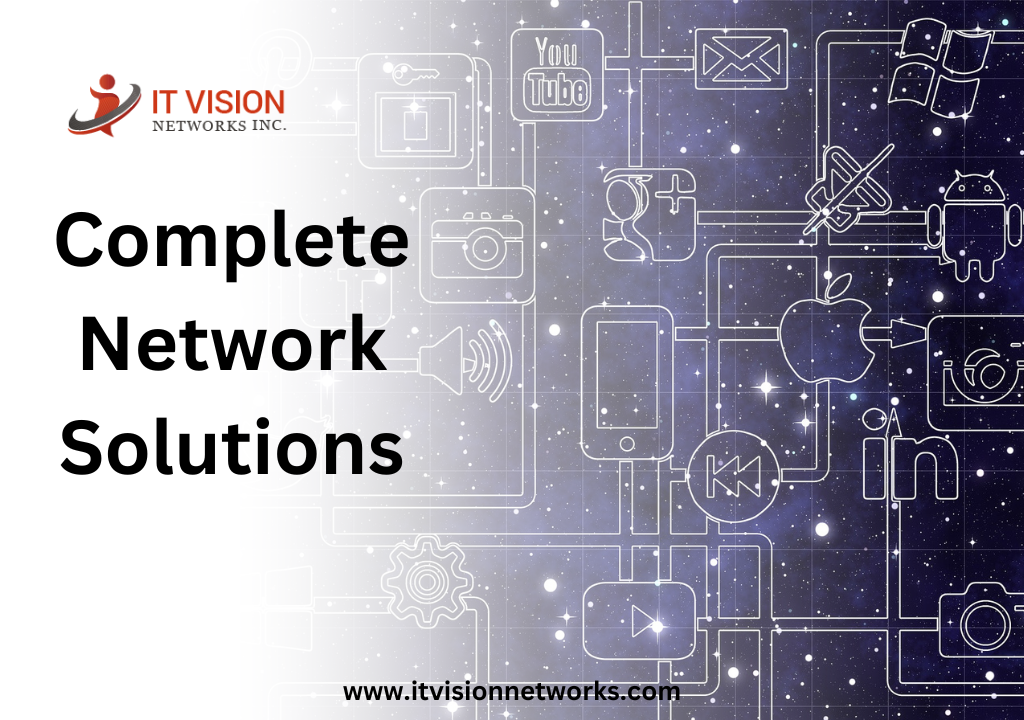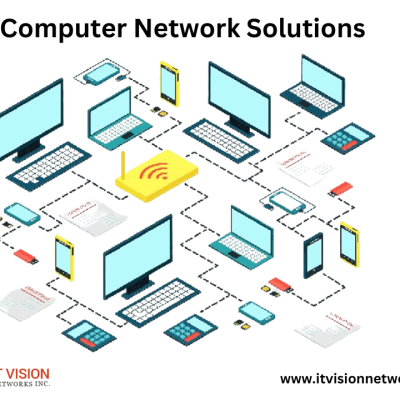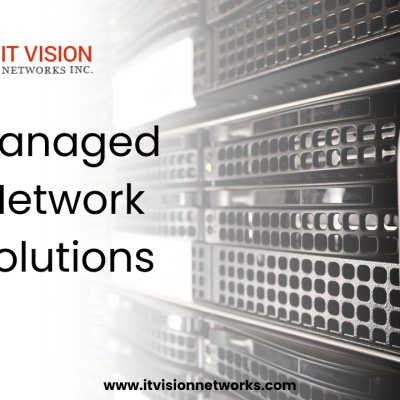According to a study by Network Computing, complete network solutions can improve network performance by up to 30%. This highlights the importance of investing in complete network solutions that address all aspects of your network infrastructure. Additionally, a study by Nemertes Research indicates that network outages can cost employees an average of 60 minutes per workday in lost productivity. Businesses can significantly improve productivity by implementing network solutions that ensure uptime. This ultimate guide will explore the step-by-step approach to building and scaling complete network solutions for long-term success.
Understanding the Importance of Network Solutions in Business
A dependable and secure network infrastructure is crucial for companies of all sizes in today’s connected world. A variety of technologies, protocols, and tactics are included in network solutions, which facilitate easy data transport and communication between users and devices. It provides the foundation for various business-critical applications such as email, file sharing, customer relationship management (CRM) systems, and more.
A complete network solution goes beyond basic connectivity and addresses the needs of the modern business environment. It ensures high availability, scalability, and security to support the growing demands of users and applications. By investing in a comprehensive network solution, businesses can streamline operations, enhance collaboration, and gain a competitive edge in today’s digital landscape.
Key Components of a Complete Network Solution
A complete network solution comprises several key components that create a robust and reliable network infrastructure. These components include:
- Network Hardware: This includes switches, routers, firewalls, access points, and other devices that form the physical backbone of the network. Choosing the right hardware is crucial to ensure optimal performance, scalability, and security.
- Network Software: Network solutions rely on software to manage and control various network devices. This includes operating systems, network management software, security software, and other applications that enable efficient network administration.
- Network Security: Network security is a critical component of any network solution. It involves implementing measures to protect the network from unauthorized access, data breaches, malware attacks, and other security threats. This includes firewalls, intrusion detection systems, virtual private networks (VPNs), and other security protocols.
- Network Monitoring and Management: To ensure the smooth operation of the network, it is essential to have robust monitoring and management tools in place. Network monitoring software allows businesses to proactively identify and resolve issues, optimize performance, and ensure uptime.
- Network Connectivity: The solution should provide reliable connectivity options to connect various devices and locations. This includes wired Ethernet connections, wireless connectivity, and virtual private networks (VPNs) for remote access.
By understanding and considering these key components, businesses can build a comprehensive network solution that meets their needs and sets the foundation for future scalability.
Assessing Your Network Needs and Goals
Before building a network solution, assessing your organization’s network needs and goals is essential. This involves evaluating your current infrastructure, identifying pain points, and defining your objectives for the new network solution. Start by conducting a thorough network audit to gain insights into your network infrastructure. Evaluate network performance, security vulnerabilities, bandwidth requirements, and scalability limitations. Identify areas that need improvement and prioritize them based on their impact on your business operations.
Next, define your network goals and objectives. Consider factors such as the number of users, anticipated growth, expected network traffic, and the types of applications and services running on the network. This will help you determine your network solution’s scalability, performance, and security requirements.
Additionally, consider any regulatory compliance requirements or industry-specific standards your network solution must adhere to. This could include data protection regulations, privacy laws, or specific security standards for industries such as healthcare or finance. By thoroughly assessing your network needs and goals, you can create a solid foundation for designing and implementing an effective network solution that aligns with your business objectives.
Planning and Designing Your Network Infrastructure
Once you have assessed your network needs and goals, the next step is to plan and design your network infrastructure. This involves mapping out the network topology, selecting the appropriate network devices, and determining the configuration and placement of these devices.
Start by creating a network diagram that illustrates the layout and connectivity of your network. This will help you visualize the network infrastructure and identify potential bottlenecks or points of failure. Consider factors such as the physical layout of your office or data centre, the location of users and devices, and the connectivity requirements between different network segments.
Next, select the appropriate network devices based on your requirements. This includes switches, routers, firewalls, access points, and any other specialized devices your network solution may require. Consider factors such as the number of ports, throughput capabilities, security features, and compatibility with your existing infrastructure.
Once you have selected the network devices, determine their configuration and placement. This includes defining IP address schemes, VLAN configurations, routing protocols, security policies, and other network settings. Ensure your network design adheres to best practices for security, scalability, and performance. You can create a solid foundation for implementing a robust and scalable network solution by carefully planning and designing your network infrastructure.
Implementing and Configuring Network Devices
After planning and designing your network infrastructure, it’s time to implement and configure the network devices. This involves physically setting up the devices, connecting them to the network, and configuring them to ensure proper operation.
Start by physically installing the network devices in their designated locations. This includes mounting switches, routers, and access points in appropriate racks or cabinets and connecting them to power sources and network cables. Ensure the devices are installed in a secure and well-ventilated environment to prevent overheating and unauthorized access.
Next, establish connectivity between the devices. This includes connecting switches and routers using Ethernet cables, configuring wireless access points for wireless connectivity, and establishing VPN connections for remote access. Ensure that all connections are properly terminated and labelled for easy identification.
Once the physical connections are established, proceed with configuring the network devices. This involves accessing the device’s management interface through a command-line interface (CLI) or a web-based user interface (UI) and entering the necessary configuration commands. Configure settings such as IP addresses, VLANs, routing protocols, security policies, and other parameters specific to your network solution.
Following best practices and security guidelines when configuring network devices is important. Implement strong passwords, enable encryption protocols, and reduce unnecessary services to minimize security risks. Regularly update firmware and software versions to ensure compatibility and access to the latest features and security patches. By properly implementing and configuring network devices, you can ensure that your network solution operates as intended and provides the necessary connectivity and security for your business.
Testing and Troubleshooting Your Network Solution
Once the network devices are implemented and configured, thoroughly testing and troubleshooting the network solution is crucial. This involves verifying connectivity, testing network performance, and identifying and resolving issues or bottlenecks.
Start by conducting basic connectivity tests to ensure all devices are properly connected and accessible. Ping each device from a central location to verify connectivity and measure response times. Ensure that devices can communicate with each other within the network and access external resources such as the internet.
Next, perform network performance tests to evaluate your network solution’s bandwidth and throughput capabilities. Use network analyzers or bandwidth testing software to measure data transfer rates, latency, and packet loss. Identify any areas of congestion or performance degradation and optimize network settings accordingly.
If any issues or errors are encountered during testing, it is important to troubleshoot and resolve them promptly. This may involve reviewing configuration settings, checking for hardware or software defects, or analyzing network traffic for anomalies. Use network monitoring tools to proactively identify and resolve issues before they impact your business operations. Document any troubleshooting steps and resolutions for future reference. This will help streamline the troubleshooting process in case similar issues arise. By thoroughly testing and troubleshooting your network solution, you can ensure that it meets your performance and reliability expectations and address any issues before they affect your business operations.
Scaling and Expanding Your Network Solution
As your business grows and evolves, it is essential to scale and expand your network solution to accommodate increasing demands. This involves adding new devices, upgrading existing infrastructure, and optimizing network settings to support additional users, applications, and locations.
When scaling your network solution, consider factors such as the anticipated growth rate, the number of new users or devices, and the expected increase in network traffic. Evaluate your network infrastructure and identify areas requiring additional capacity or performance upgrades.
To add new devices to your network, follow a similar implementation and configuration process described earlier. Ensure the new devices are compatible with your existing infrastructure and adhere to your network design and security policies. Test and validate the connectivity and performance of the new devices to ensure seamless integration with the existing network.
As your network solution scales, it is important to periodically reassess and optimize network settings. This includes reviewing and adjusting IP address schemes, VLAN configurations, routing protocols, and security policies to accommodate the growing network. Regularly monitor network performance and utilization to identify potential bottlenecks or areas requiring optimization.
Additionally, consider implementing network management tools that provide centralized visibility and control over your network infrastructure. These tools can streamline network administration tasks, automate configuration changes, and provide real-time monitoring and alerts for proactive issue resolution. By scaling and expanding your network solution effectively, you can ensure that it continues to meet the growing demands of your business and supports future growth and innovation.
Troubleshooting Common Network Issues
Network issues can still occur even with a well-designed and implemented network solution. It is important to be prepared to troubleshoot and resolve common network issues to minimize downtime and ensure optimal network performance.
Some common network issues include:
- Connectivity Problems: Users may experience intermittent or complete loss of network connectivity. Faulty cables, misconfigured devices, or issues with network protocols can cause this. Troubleshoot connectivity issues by checking physical connections, verifying IP configurations, and testing network protocols.
- Slow Network Performance: Slow network performance can result in sluggish application response times and file transfer speeds. Network congestion, bandwidth limitations, or inefficient network settings can cause this. Troubleshoot slow network performance by identifying bandwidth-hungry applications, optimizing network settings, and implementing quality of service (quality of service) policies.
- Security Breaches: Network security breaches can result in unauthorized access, data breaches, and compromised network integrity. Weak passwords, outdated security protocols, or malware attacks can cause this. Troubleshoot security breaches by conducting regular security audits, implementing strong access controls, and keeping security software and firmware up to date.
- DNS Resolution Issues: DNS resolution issues can result in users being unable to access websites or resources by their domain names. This can be caused by misconfigured DNS servers or issues with DNS caching. Troubleshoot DNS resolution issues by verifying DNS server configurations, flushing DNS caches, and performing DNS lookups and queries.
When troubleshooting network issues, it is important to follow a systematic approach. Start by gathering information about the issue, such as error messages, affected devices or users, and recent changes to the network. Use network monitoring tools to gain visibility into network traffic, performance metrics, and error logs.
Next, isolate the issue by testing device connectivity, verifying network configurations, and analyzing network traffic. Use network diagnostic tools and command-line utilities to perform traceroutes, ping tests and packet captures. This will help identify the root cause of the issue and guide the troubleshooting process.
Finally, the necessary steps must be implemented to resolve the issue. This may involve adjusting network settings, replacing faulty hardware, updating firmware or software versions, or implementing additional security measures. Document the troubleshooting steps and resolutions for future reference and to streamline the troubleshooting process in case similar issues occur. You can minimize downtime, optimize network performance, and ensure a seamless user experience by being prepared to troubleshoot and resolve common network issues.
Tips for Maintaining and Optimizing Your Network Solution
Maintaining and optimizing your network solution is an ongoing process that requires regular monitoring, updates, and fine-tuning. Here are some tips to help you keep your network solution running smoothly:
- Regularly monitor network performance and utilization using network monitoring tools. This will help you identify potential bottlenecks, plan for capacity upgrades, and proactively address performance issues before they impact your business operations.
- Keep your network devices and firmware/software versions up to date. Manufacturers regularly release updates that address security vulnerabilities, introduce new features, and improve performance. Regularly check for updates and apply them as appropriate.
- Implement strong access controls and security measures to protect your network from unauthorized access and data breaches. This includes using complex passwords, implementing two-factor authentication, and regularly reviewing and updating security policies.
- Regularly back your network configurations and critical data. This will help you recover quickly in case of a network failure or data loss. Store backups in secure locations and regularly test the restore process to ensure their integrity.
- Conduct regular security audits and vulnerability assessments to identify potential security risks. Use penetration testing tools and techniques to simulate real-world attacks and identify vulnerabilities malicious actors could exploit.
- Regularly review and optimize network settings to ensure optimal performance. This includes reviewing IP address allocations, VLAN configurations, routing protocols, and quality of service settings. Adjust settings as needed to accommodate changes in network requirements.
- Train your IT staff and end-users on network best practices and security awareness. Educate them about the importance of strong passwords, safe browsing habits, and recognizing social engineering attacks. Regularly reinforce these practices to ensure a security-conscious culture within your organization.
By following these tips, you can maintain a secure and optimized network solution that meets the evolving needs of your business.
Conclusion
Building and scaling complete network solutions require careful planning, design, implementation, and maintenance. By understanding the importance of network solutions in business, identifying the key components of a complete network solution, assessing your network needs and goals, and following a step-by-step approach, you can build a robust and reliable network infrastructure that supports your business objectives.
Remember to regularly review and optimize your network solution, troubleshoot common network issues, and implement security best practices to ensure your network’s ongoing performance, security, and scalability. With a well-designed and maintained network solution, you can enhance your organization’s productivity, collaboration, and innovation and gain a competitive advantage today.






